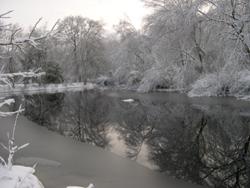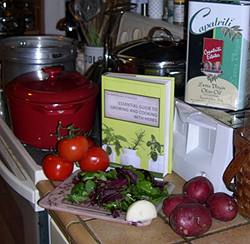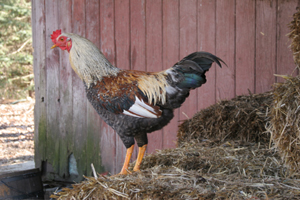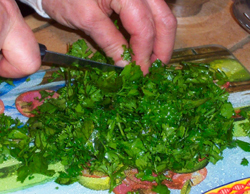
|
Then bundle up and off to the garden. Collect any herbs that are still green and any root crops that are still around. Beets survive most weather. Luckily the parsley is still there with some plants in the row hanging on. We watch the few renegade fowl not
in the pen yet, as they scratch around eating weeds, seeds and insects. I
noticed that when I allow them to forage all winter the zucchini, gourds, and
pumpkin are much healthier, with few or no borers in the vines the following
summer. So it is‚ “Here chick, chick, chick,” on frosty mornings. It is
surprising that even the roosters and hens roosting in far away holly and cedar
tr Bulbs forgotten in fall? You can
plant them now rather than let them shrivel and dry. A good 8-10 weeks of cold
will allow roots to form and then they will still have time to send up green
shoots and bloom this spring. Plant any time you can dig and the
Cold, hardy seeds that would
normally drop from seedpods in fall can be scattered now. Scratch some soil in
sunny spot and scatter Larkspur, Cornflower, Poppy, Calendula and Nigella seeds,
as well as dill and parsley. Tamp in or cover very lightly with some grains of
soil. Water if it is dry and come March they will sprout just as the ones nature
planted will. I love the early Poppy and Cornflowers that bloom in time for
Memorial Day when the seeds drop naturally into the soil. It is still winter, so
don't go over b Pick a few branches to force. Forsythia, winter sweet, pussy willow and others will all bloom in a vase indoors. Once back in the house I tend the soup. Pull out the bones that were boiling to make the stock. Add a couple of cans of crushed or chefs cut tomatoes to the soup as well as a handful of barley, lentils, split peas, dried corn and dried beans to the soup. Be sure there is plenty of liquid to cover these. Peel and chop carrots, more celery, some cabbage and a beet or two. After the dried materials have gently simmered for 35 minutes or so, add the hard vegetables to the simmering soup pot.
Stir the soup, add liquid if
needed. Go back outside to fill feeders or walk a bit. We like to go up
near Franklinville Lake or back to our creek to tak Upon returning to the house, add a few frozen vegetables such as peas or string beans to the soup. Stir a bit and turn off. Sprinkle with salt, pepper, and parsley. When serving, sprinkle with Parmesan cheese and enjoy a glass of wine and some crusty Italian bread and butter with the soup. Add a healthy ending the winter supper by slicing up oranges and a few grapes. You might even have a few Christmas cookies left to enjoy with coffee or tea in front of the bird feeder window. Enjoy. Visit Lorraine online at www.TripleOaks.com |
 Many gardeners love to get outside
no matter what the weather. I am always eager to look at the garden when I go
out to feed the chickens or fill the bird feeders. It is important to take some
deep breaths and enjoy the frosty weather. There is a certain beauty in the
landscape when the stark reality of winter bares so much. Trees are outlined
against the sunset or early morning light in a different way than in summer.
They are most beautiful after a snow. Thinking back to the heat and drought of
late last summer and fall I am quite thankful for winter rain (we did get a lot
so far this winter), snow and cold.
Many gardeners love to get outside
no matter what the weather. I am always eager to look at the garden when I go
out to feed the chickens or fill the bird feeders. It is important to take some
deep breaths and enjoy the frosty weather. There is a certain beauty in the
landscape when the stark reality of winter bares so much. Trees are outlined
against the sunset or early morning light in a different way than in summer.
They are most beautiful after a snow. Thinking back to the heat and drought of
late last summer and fall I am quite thankful for winter rain (we did get a lot
so far this winter), snow and cold. If you have chores to do outside,
think first of making soup at the same time.
If you have chores to do outside,
think first of making soup at the same time. ees come running when we cluck, call them and rattle the corn can. It is okay,
however, that they ignore my call when the big ole red-tailed hawk sits in
nearby trees. Those safely in the pen and hen house await any greens from the
kitchen or garden that we throw to them. It all ends up in the compost
eventually. We still get a few eggs each day, despite the shorter hours of
daylight, but this will increase, as the days get longer. Our eggs are in
various shades of tan and brown with a few pale green or blue from time to time.
ees come running when we cluck, call them and rattle the corn can. It is okay,
however, that they ignore my call when the big ole red-tailed hawk sits in
nearby trees. Those safely in the pen and hen house await any greens from the
kitchen or garden that we throw to them. It all ends up in the compost
eventually. We still get a few eggs each day, despite the shorter hours of
daylight, but this will increase, as the days get longer. Our eggs are in
various shades of tan and brown with a few pale green or blue from time to time.
 soil is not
frozen.
soil is not
frozen. oard since only a few cold hardy seeds need the freeze and thaw
to best germinate. I did six packs of poppy and larkspur. Hopefully they will
take and not be eaten by chickens or birds. Sometimes I cover them with a piece
of burlap to protect them.
oard since only a few cold hardy seeds need the freeze and thaw
to best germinate. I did six packs of poppy and larkspur. Hopefully they will
take and not be eaten by chickens or birds. Sometimes I cover them with a piece
of burlap to protect them. While this slowly simmers and
cooks continue the gardening indoors and shower houseplants checking for
insects. Wipe any that the shower missed. If insects are a problem use a sticky
stripe or spray with safe insecticide soap or neem oil. These are safe organic
solutions that will rid houseplants of pests. (But always follow directions.) You
might want to give a dose of Osmocote time-release fertilizer now so as the days
lengthen there is food for new growth.
While this slowly simmers and
cooks continue the gardening indoors and shower houseplants checking for
insects. Wipe any that the shower missed. If insects are a problem use a sticky
stripe or spray with safe insecticide soap or neem oil. These are safe organic
solutions that will rid houseplants of pests. (But always follow directions.) You
might want to give a dose of Osmocote time-release fertilizer now so as the days
lengthen there is food for new growth. e a look at waterfowl or
small songbirds in thickets near the edge of the lake.
e a look at waterfowl or
small songbirds in thickets near the edge of the lake.